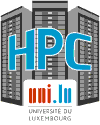10 years after the installation of the first research computing platform at the UL, two new clusters (iris and aion) will be deployed starting 2017 as part of the renewal of the UL HPC facility to enable the UL researchers and their collaborators to continue and expand their ground-breaking work in more than 25 computational sciences fields.
2016 investment from the UL HPC budget line have been mainly devoted to the renewal of the UL HPC platform and the introduction of a new compute cluster (named iris) to cover the needs of new user groups who joined the UL recently. In this context, 2 public tenders were issued and attributed in Dec. 2016:
-
RFP 160019: High Performance Storage of capacity 1.44 PB (raw) (over
GPFS/SpectrumScaleFilesystem), with a RW performance > 10GB/s -
RFP 160020: High Performance Computing (HPC) cluster of effective capacity Rmax = 94.08 TFlops (raw capacity Rpeak = 107.52 TFlops)
- 100 nodes, 2800 cores, and per node:
- 2x Intel Xeon E5-2680v4 14C@2.2 GHz
- 128GB RAM
- High throughput, very low latency and high reliability interconnect relying on a Fat-tree topology over Infiniband Mellanox EDR 100Gb/s technology.
- 100 nodes, 2800 cores, and per node:
The installation of the iris cluster within the UL Centre de Calcul (CDC) is expected to start on March, 6th 2017 and will last between 2 and 3 weeks. The physical racking of the equipment is only the first (easy) step, we estimate at ~1 month the time required afterwards to configure and validate the platform. This new cluster will bring many disruptive changes to the current setup:
- new batch scheduler (SLURM)
- containers support (Shifter), compliant with Docker
- and so much more we will detail at the 2017 UL HPC School.
In practice, we target a production release date for the iris cluster around April 22th, 2017, i.e. ~10 years after the initial installation of the first research computing platform at the UL. The 2017 UL HPC School will be organized shortly afterwards to present the new cluster.
Of course, this cluster will enable the UL researchers and their collaborators to continue and expand their ground-breaking work in more than 25 computational sciences fields, while waiting for the deployment of a DLC-based1 HPC cluster (named aion) which will be our focus starting mid-2017. Note that we depend for this last deployment on the delivery of the operational server rooms within the Centre de Calcul (CDC) S-02 able to host such equipment, which is currently planned for Q4 2017.
1: DLC (or Direct Liquid cooling) uses a hollow metallic connection to parts of a server, such as CPU or memory. Through it, liquid flows taking the heat away within the server chassis in a more efficient way than regular air-flow based cooling. This cutting-edge cooling technology is not only cost-effective as it drastically increases the potential server density, but it also allows higher water temperatures i.e. less chiller infrastructure. DLC-based deployment is expected to become the standard for enabling energy-efficient and cost-effective computing infrastructure at large scale, and thus the target of future UL HPC installations.
